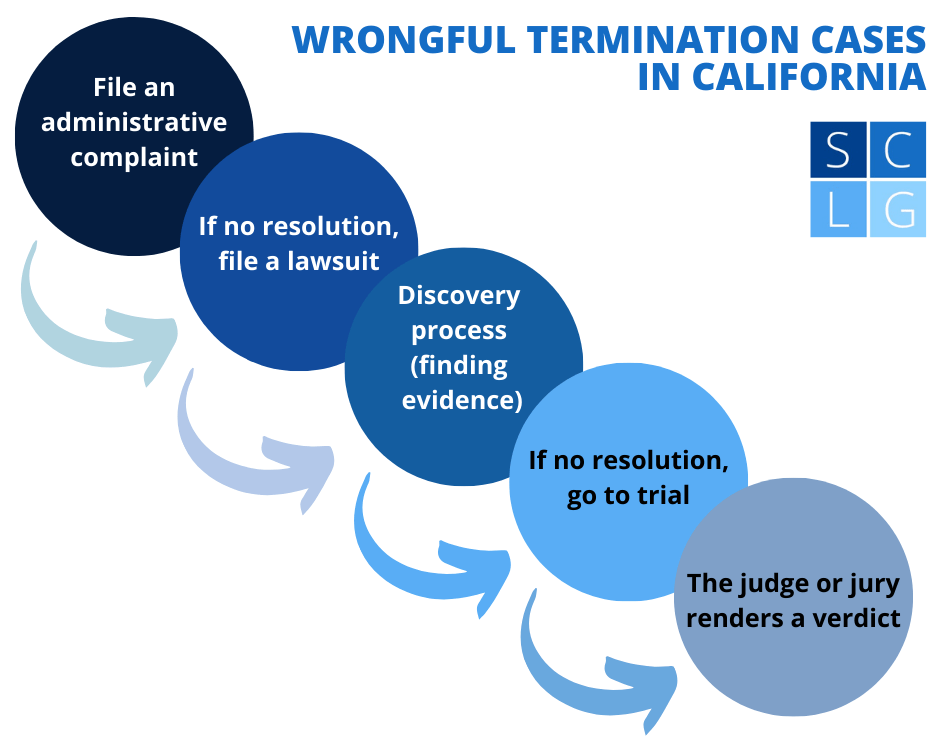
Wrongful termination lawsuits can take over a year to resolve. Every case is different, however. If the employer is eager to settle out of court, the case can end in a matter of weeks. If either side is intent on going to trial, a wrongful termination claim could linger on for several years.
Currently, many court systems are severely backlogged. This can further prolong a case, especially one that goes into full litigation.

What is wrongful termination?
A wrongful termination happens when an employer discharges you for an illegal reason. Even if you are an at-will employee, you can be protected by wrongful termination laws.
Some of the most common types of wrongful termination include:
- breaching an implied employment contract,
- breach of contract, if there was a valid employment contract,
- discrimination,
- violating public policy by illegally retaliating against you for:
- filing a workers’ compensation claim,
- reporting sexual harassment in the workplace,
- engaging in political activities, or
- whistleblowing.
If you think that you have been illegally fired, you can file a wrongful termination lawsuit. In most states, successful cases can recover verdicts or settlement amounts that cover your:
- lost wages and benefits, including back pay, front pay, and non-salary benefits like health insurance,
- emotional distress,
- attorney’s fees, and
- punitive damages, if the employer behaved particularly badly.
How long can a wrongful termination case take?
There are numerous factors that can impact how long a wrongful termination case can last. Generally, though, they take a little over a year to resolve from the time they are first filed in court. If the case gets appealed, though, it can last even longer.
The factors that tend to make a difference in the length of a claim include:
- the employer’s interest in settling the claim out of court,
- whether the termination was clearly illegal or not,
- the size of the employer and whether they have in-house employment lawyers to handle the case,
- whether the former employer or you are intent on taking the case to trial,
- the potential damage to the employer’s reputation,
- the amount of legal damages at issue, and
- whether the law has an administrative process that has to be exhausted, first.
Each of these factors, and others, can drastically increase or decrease the time it takes to resolve the dispute. For example, if the claim only concerns a small amount of damages, big employers may choose to settle the case within weeks of it being filed.
What are the steps in a wrongful termination lawsuit?
The wrongful termination cases that take the longest are those that go to trial. If the case is settled out of court, it will not last as long. There are several parts of the process where settlements tend to occur. If the case goes all the way to trial, though, all of these steps will have to be completed.
Administrative process or agency complaints
Some state or federal laws that protect workers from wrongful terminations provide for administrative remedies. Before taking the case to court, you have to pursue and then exhaust these remedies. This process can take around a year, on its own.
For example, if you are a whistleblower who reports securities fraud in the workplace, you are protected from a retaliatory termination by the federal Sarbanes-Oxley Act. However, the Act does not let you go straight to court. Instead, you have to file a complaint with the United States Secretary of Labor, or one of its designees, within 180 days. After the complaint is filed, the Secretary has another 180 days to act on it. Only if the Secretary does nothing can you file a wrongful termination lawsuit in federal court.1 By this time, nearly a year has passed.
The process is similar for employment discrimination cases under Title VII. This federal employment law forbids discrimination in the workplace based on things like:
- sexual orientation,
- national origin,
- race,
- gender, and
- sex.
Like the Sarbanes-Oxley Act, Title VII requires you to file a complaint, first. This complaint goes to the Equal Employment Opportunity Commission (EEOC). If you and your employment law attorney try to file your case in court before going to the EEOC, the court will refuse to hear the case. Meanwhile, the time limit to file the complaint will be ticking away.
During the administrative remedy process, the government agency handling the complaint will try to resolve the case. They often facilitate mediation or arbitration between the parties. If the former employer and you come to a mutually-satisfactory agreement, this can end the case before it ever enters a court.
Filing the lawsuit in court
The next step is to file the wrongful termination case in court. It is always best to establish an attorney-client relationship with a wrongful termination lawyer before filing the complaint. It has to be done before the statute of limitations has expired.
Filing the lawsuit often triggers a round of negotiations between the former employer and you. In some cases, this can lead to a wrongful termination settlement within only a few months. In other cases, both sides realize that they are close enough to settling to take the case to mediation or arbitration, instead.
Discovery process
The discovery process is the stage where each side in the lawsuit gathers evidence to build your respective cases. As evidence is unearthed, it may become clear that the termination was lawful or unlawful. If it looks like the employer violated your rights, the employer may try harder to settle the case. If it looks like the termination was legal, it can put pressure on you to drop the lawsuit.
The discovery process can take several months after the lawsuit is filed. During this time, both sides will face depositions, interrogatories, and requests for other information.
Summary judgment stage
It is common for both sides to file a motion for summary judgment, asking the court to rule on the case without a trial. The judge will only resolve the case this way if there are no material facts that are still in dispute.
If the wrongful termination case is resolved at the summary judgment stage, it will often end around nine months to a year after it was filed.
Trial
If there is no settlement, then the case will go to trial. Most wrongful termination trials last a couple of days. However, if there are complicated facts, the trial can take up to several weeks.
By the time the time the trial is over, more than a year has usually passed since the lawsuit was filed in court. If there were administrative remedies to exhaust, first, two years may have passed. If the losing side appeals after the trial, it can add another year to the process.
What about the statute of limitations?
The statute of limitations is a law that requires wrongful termination lawsuits to be filed before a certain period of time has passed since the termination. The applicable statute of limitations will depend on the nature of the claim and the law that was allegedly violated.
You have until the statute of limitations has expired to file your complaint in court. In some cases, it is best to initiate the case right away. In others, it can be wiser to wait. An experienced wrongful termination lawyer from a local law firm can provide the legal advice that you need to act in your best interest.
If you and your attorney decide to wait, it can add a significant length of time – up to several years – between the termination and the end of the employment lawsuit.
What is the law for wrongful termination claims in California?
Under California law, the timeframe for a wrongful termination claim is similar to other states. However, many wrongful termination cases fall under the California Fair Employment and Housing Act, or FEHA. The FEHA is the main state law for employment issues. It requires you to file a complaint with the Civil Rights Department (CRD), first.2 This complaint has to be filed within three years of the day the employer wrongfully fires you.3
Once it has received a complaint, the CRD will either pursue the case on its own or issue a “right to sue” notice. The “right to sue” notice gives you permission to pursue the case on your own.
Once you have received the “right to sue” notice, you have one year to file the lawsuit in state court.4 If this amount of time passes and the lawsuit has not been filed, it can easily be dismissed by the former employer.
Once the lawsuit has been filed, it often takes over a year for these employment cases to resolve.
Additional reading
For more in-depth information, refer to these scholarly articles:
- Past, Present, and Future in Wrongful Termination Law – Labor Lawyer.
- Duration Of Employment In Wrongful Termination Cases – Journal of Forensic Economics.
- New Developments Concerning Wrongful Constructive Termination – Managerial Law.
- Determining economic damages from wrongful termination – Plaintiff Magazine.
- Constructive Termination Must Be Recognized in Wrongful Termination Cases as a Matter of Law: Plaintiff’s Duty to Mitigate Damages – Charlotte Law Review.
Legal References:
- 18 U.S.C. 1514A.
- California Government Code 12965 GC.
- California Government Code 12960 GC.
- California Government Code 12965 GC.

